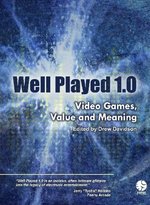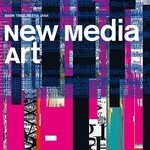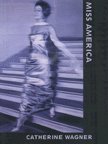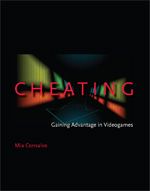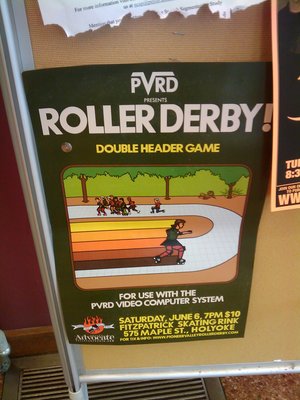
Playing the Irish Game, Talking About Train

I got to hear Brenda Brathwaite speak about her recent work yesterday. As you know if you’re read the Escapist article about her board games, she’s been developing a series of non-digital games about very serious subjects: The middle passage, Cromwell’s invasion of Ireland, and the Holocaust – so far. I also got to talk with her and some others about Train (upper right) at the GAMBIT Game Lab and got to play against her there in Siochan Leat (lower left). The latter, also known as “The Irish Game,” is a very playable game, although in my limited experience, it seems like it may have too many symmetries. I tried to play for a draw (since that seemed like a “fair” outcome), forgot about a rule and fell behind, and then caught up again to draw the game in the end. Since Train was “spoiled” for me and others, we talked about the play that had taken place in other sessions, and ended up having a very interesting discussion. I have no problem with games that rely on the players being naive, and which can be played only once, as long as that one experience is valuable. The verbal game Max and Nora is like this, and the way that some people play the party game Psychiatrist is similar, also. The latter game can easily be generalized, though, and can be endless fun (and insightful) if it is. Train is about something quite different: the drive for efficiency that obscures the ethics of one’s action. It is meant to provoke substantial conversation, and it does that well, helping us think about the nature of play and the design of games as well as about an important historical episode.

These games impressed me as very thoroughly thought through on a material as well as a formal level. They also impressed me as original, unique art works, a quality which in some ways contributes to their ability to tackle difficult subjects. I do think that it works against their purpose in some ways, though. Many more people could play and benefit from these games if they were cheap or “open,” rather than unique. Still, I can’t complain about the project, and I’ll look forward to the next games in Brathwaite’s series.
“Platforms” and Positioning
Tarleton Gillespie, author of Wired Shut: Copyright and the Shape of Digital Culture, presented an interesting paper at MIT’s Media in Transition 6 conference – one that is helpfully available online, and which is called “The Politics of ‘Platforms.'”
Gillespie considers the way that YouTube and other companies in the business of “content hosting” have positioned themselves as offering “platforms” – a stance that has populist benefits and which at least has the potential to distance these companies from liability for material they serve up. Interestingly, Gillespie finds that the computational sense of platform pre-dates this Web 2.0 and content-delivery sense. Admittedly, that sense, too, is a relatively new way of thinking about platform, and the most recent OED sense. Gillespie quotes this fine blog post by Marc Andreessen:
The key term in the definition of platform is “programmed”. If you can program it, then it’s a platform. If you can’t, then it’s not.
So, if you’re thinking about computing on the Internet, whenever anyone uses the word “platform”, ask: “Can it be programmed?” Specifically, with software code provided by the user? If not, it’s not a platform, and you can safely ignore whoever’s talking — which means you can safely ignore 80%+ of the people in the world today who are using the term “platform” and don’t know what it means.
This, by the way, is essentially sense of platform that the Platform Studies book series aims to investigate, although we don’t advocate that people ignore Google, YouTube, and so on.
The focus of the series is on computational platforms not because Ian and I disdain other uses of the word “platform” – we certainly don’t when we go to train stations – but because this is a particularly fertile area for digital media investigations, as we tried to show in Racing the Beam. Platform studies is an essentially computational as well as cultural endeavor, one that works to connect computation (not communication alone) to human creativity of various sorts.
Gillespie doesn’t buy Andreessen’s take on platforms, writing, rather, that “[p]latforms are platforms not necessarily because they allow code to be written or run, but because they afford an opportunity to communicate, interact, or sell.” A descriptive linguist would be hard-pressed to argue with this. The concept of platform is a rich one, and Gillespie’s paper delves into the rhetoric and politics of its use by media companies. I think a better understanding of the way computational platforms work and how they have influenced culture – a better view of those obscure, arcane platforms that have been little studied from cultural perspectives but which gave their name to the communication platforms of today’s web – will not only let us learn more about computing and creativity. It will also leave us better equipped to deal with what “platform” means in other contexts, the issue that Gillespie has very usefully started to explore.
Guardian Hails IF, Novelists
Keith Stuart’s provocative article in The Guardian plugs modern-day interactive fiction and suggests that novelists should be more involved in the making of video games, as they have been in the past. The article is on the right track. There is certainly reason for video game companies to license, or, less frequently, collaborate with those who make movies. But there are lots of things that games can do, and novelists could bring interesting perspectives, skills, and art to games – even they aren’t text-based interactive fiction. Of course, the right match has to be made and the writer has to be persuaded that video games are serious enough. I suggest Ubisoft grab Paul Auster, a dizzying writer. If he didn’t mind the association that come with writing and co-directing the movie Smoke, video games should be no problem.
Thanks to Emily Short for noticing this one.
Poemland
Minnis, confronting poetry, hurls a fruit salad. The pages of the eleven sections of this book have only a few lines each, most ending in ellipses. The images (“getting hit with a folding chair / And being held by your braids…”) accumulate and converse (“I’ll chop your head off! / And I’ll carry it around by the hair…”), commenting on various vague situations and on poetry (“It’s like trying to drink a bottle of champagne in a roadside bathroom…”) You might imagine that it’s boring to hear poets yammer about writing poems and being poets (“If you open your mouth to start to complain I will fill it with whipped cream…”). Not so. Via references to fashion and offbeat interpersonal statements, the lines of Poemland connect the concerns of our poetry subculture (poverty, recognition, originality, connection to the past, authenticity) to culture more broadly. The book is fun to read from line to line, too (“With this book I have made a very expensive joke…”) and is beautifully and aptly designed.
CALC-09, Afternoon
The Workshop on Computational Approaches to Linguistic Creativity has just concluded. I posted about the morning; here are my notes on the afternoon talks.
The first item for the afternoon was my invited talk, “Curveship: An Interactive Fiction System for Interactive Narrating” I worked a while to provide the paper to accompany my talk, trying to introduce IF, explain the basics of narrative variation, and get into at least some of the technical details of my system, including the string-with-slots representation, which I’ve been working on a great deal recently. I also tried to include handy references and pointers. Incidentally, I’ve been meaning to post more about Curveship, and I’d love to hear any questions you have about it at this point, even before I’ve properly introduced the system on this blog.
After my talk, we had more time for poster presentation; one poster was on author and character goals for story generation.
The “From Morphology to Pragmatics to Text” session concluded the day:
Andrew Goldberg presented work by three others on a ML algorithm to assess the creativity of sentences: outliers that are still meaningful. The Winconsin Creative Writing dataset was assembled and used. Using language modeling, word norms, and WordNet, the did partially predicted creativity scores. (Pointed out in the Q&A: All the non-creative sentences were much shorter, so you could just use one feature – length!)
Stefano Vegnaduzzo presented state-of-the-art work on complex adjectives – ones that are made of at least two words separated by a hyphen. These are frequent, as corpus analysis of Wikipedia and the Web shows. Two-word complex adjectives, identified with a part-of-speech tagger, were the focus. Morphological productive processes allow the unintentional, unlimited, regular creation of words; building complex adjectives is one. Checking for hapax legomena gives a measure of productivity within morphological categories: “non-X” was tops in both corpora. Realized and potential productivity were found, and found to be similar across corpora.
Allan Ramsay presented work on how the same words can have different meanings in different contexts. The sentence “I’m sorry I missed your talk” was one fixed text, along with “I’m sorry, Dave, I can’t do that.” It’s not because “sorry” is ambiguous. “Sorry” expresses a relationship between an individual and a state of affairs (which the individual wishes were not the case). There’s no first-order representation. The representation is extremely elaborate, but not too complex. Appropriate background knowledge is essential. One conclusion: A system that takes part in conversations will have to build meaning representations and carry out inference. (In Q&A, I learned that there’s more in the paper about being mistaken, lying, and using irony and sarcasm.)
One way to get at the papers from this workshop is by seeing the title and author information on the CALC-09 site and then using your favorite search engine to locate them online – I assume all, or at least almost all, have been placed online by authors. ACL also offers past workshop proceedings for purchase. Maybe the CALC-09 proceedings will be available that way, too?
CALC-09, Morning
The Workshop on Computational Approaches to Linguistic Creativity (CALC-09) is taking place now at the University of Colorado at Boulder.
In the first session on metaphors and eggcorns, researchers reported on using natural language understanding techniques in innovative ways:
Beata Beigman Klebanov presented on the use of a topic model (LDA, latent Dirichlet allocation) to detect the most obvious or deliberate types of metaphor, which are discussions of one domain the terms of another and which were annotated by people in this experiment. For different k, metaphorical uses were found to be less frequent in the k most topical words in the discourse overall.
Steven Bethard presented work dealing with sentence-level conceptual metaphors from a psycholinguistic standpoint. In earlier work, metaphors were used as stimuli and subjects’ N400 brain waves, associated with anomaly, were recorded. This suggests that it’s important to know about metaphorical frequency, how often words are used in a metaphorical way. A support vector machine classifier was trained on an annotated corpus. LDA, with and without categories, was used to disambiguate metaphors, and to determine whether they are abstract or concrete.
Sravana Reddy presented “Understanding Eggcorns,” about linguistic errors caused by semantic reanalysis: entrée -> ontray, as first named on Language Log in 2003. Eggcorns are more related to folk etymology and puns than malapropism; there has been little study. Can the path of transformation be discerned? Error-detection is an application; also, humor generation. Using the Eggcorn Database and WordNet, a semantic network was built; context information was then added and other augmentations were made. A typology with five categories was developed based on the results.
Session 2 was on generating creative texts:
Ethel Ong presented work on pun generation using a pronouncing dictionary, WordNet, and (more effectively) ConceptNet. A system called TPEG extracted word relaltionships to build templates for pun generation, keeping the syntactical relationship but modeling semantic and phonetic word relationships as described in Kim Binstead’s work. Variables in the template model parts of speech, sound, and compound words.
Yael Netzer presented the Gaiku system for haiku generation. Constructed a haiku corpus, system to build templates. First try generated grammatical output, but didn’t have a good “story.” Story is a sequence of concepts: Butterfly, spring, flower. Word association information, not found in WordNet, was added. An analysis of haiku was done to see if it appears more associate than news text. The final generated haiku were evaluated in a “Turing test.”
Lyric generation in Tamil and syntactic constructions were discussed in the poster session presentations.
Note that paper titles and the full list of author names can be found on the CALC page.
New Poem: “Served Cold”
A dish for today: “Served Cold,” in the traditions of concrete poetry, search engine poetry, and poetry featuring incorrect but widely-used spellings of names.
Microchip Movers and Shakers
“25 Microchips That Shook the World,” an article by Brian R. Santo that was published this month in IEEE Spectrum, is a fascinating look at important hardware components and their historical influence – a look within various hardware platforms.
Well Played
Well Played 1.0: Video Game, Value and Meaning is now out from ETC Press. It’s available in print from Lulu.com and has been offered to the creative commons and can be downloaded as a PDF or read on the Web.
My contribution is “Portal of Ivory, Passage of Horn,” an article comparing two of the top games of 2007. Thanks to everyone who discussed this comparison with me at Grand Text Auto when I first blogged about this pair of games. My article is, I think, both more extensive and more focused than what I originally wrote, and I hope it helps to advance the discussion of video games.
Editor Drew Davidson writes of the book:
What makes a game good? or bad? or better?
Video games can be “well played” in two senses. On the one hand, well played is to games as well read is to books. On the other hand, well played as in well done.
This book is full of in-depth close readings of video games that parse out the various meanings to be found in the experience of playing a game. 22 contributors (developers, scholars, reviewers and bloggers) look at video games through both senses of “well played.”
The goal is to help develop and define a literacy of games as well as a sense of their value as an experience. Video games are a complex medium that merits careful interpretation and insightful analysis.
Well Played Table of Contents
- Introduction
- Ico – Charles Herold
- Super Mario Bros. – Patrick Curry
- Advance Wars – Noah Falstein
- Ultima Underworld – Corvus Elrod
- Bully – Kirk Battle (L.B. Jeffries)
- Half-Life 2 – Mark Sivak
- Europa Universalis – Greg Costikyan
- Zork & Kingdom of Loathing – Brett E. Shelton
- Phoenix Wright – Mia Consalvo
- Shadow of the Colossus – Nick Fortugno
- Civilization 4 – Kurt Squire
- Parappa the Rapper – Katherine Isbister
- Portal & Passage – Nick Montfort
- Silent Hill 2 – Doris C. Rusch
- Bioshock – Clint Hocking
- Metal Gear Solid 4 – James Paul Gee
- Tempest – Mary D. Flanagan
- Guitar Hero – Jason Vandenberghe
- Legend of Zelda: Ocarina of Time – Seth Sivak
- The Secret of Monkey Island – Clara Fernández-Vara
- Mines of Minos – Jesse Schell
- World of Goo – Drew Davidson
- Author Biographies
- References
Last Day Dream
Here’s a beautiful 42-second video: Last Day Dream by music video director Chris Milk.
New Media Art
Here’s a nice slice of recent digital art – online, in performance, and installed – expertly introduced. The book is well-illustrated (no surprise from this publisher) and has a welcome emphasis on the computational. Sure, some of the purest pieces of software art (Galloway’s fork bomb, obfuscated code, and the like) aren’t mentioned, but port scanning, packet sniffing, and the glitchy transformation of HTML are all represented. As with all Basic Genre Series books, there’s an introduction followed by page spreads, each on a single work. The format has its pros and cons, but the results, in this case, certainly offer a nice adjunct to Christiane Paul’s similarly introductory book, Digital Art. The engagement of artists with social issues, the critique of technology, video gaming, and free software are particularly evident in New Media Art. And, how great that Super Mario Clouds and the work of Jodi now sit on the shelf beside books on abstract expressionism, Greek art, and the still life.
Miss America
If I was President,
NONSTOP LICKY
I’m afraid I can’t think without licky
White man wrote almost every book in that shelf.
Wagner takes an exquisite sledgehammer to language and America in this book. The Magazine Poems (for Nature, Time, Social Text, etc.) and the White Man Poems (the second of which supplies the lines above) are particularly effective projects, often scatologically smeared, with phrases turned until they are permanently damaged or become protolinguistic babble. The voices nevertheless seem spot-on as they speak to intimate as well as cultural matters. The five-line poem for Cosmo ends “Horrif, horrif, she howled – Horrif.” Seems like Mistah Kurtz – he is so dead. “A Poem for Good Housekeeping (after Wittgenstein)” is in a rather different vein, rising into a biting, cool abstraction and living up to the outrageousness of its title. The concluding Fraction Anthems, procedurally pulverized further in notes to each, have fine moments as well.
Pablo Gervás to Speak at MIT
Next week, the Purple Blurb series offers a special talk by a leading European researcher in creative text generation.

Pablo Gervás works as associate professor (profesor titular de universidad) at the Departamento de Ingeniería del Software e Inteligencia Artificial, Facultad de Informática, Universidad Complutense de Madrid. He is the director of the NIL research group and also of the Instituto de Tecnología del Conocimiento.
His research is on processing natural language input, generating natural language output, building resources for related tasks, and generating stories. In the area of creative text generation, he has done work on automatically generating metaphors, formal poetry, and short films.
He will speak on Wednesday May 20, 6pm-7pm, at MIT in room 14E-310. The talk is (as with all Purple Blurb presentations) open to the public, and (as with all Purple Blurb presentations so far) will be in English.
Guru Meditation
Ian Bogost has just released his new game Guru Meditation for two platforms: Atari VCS and iPhone. Yes, really. The game is a reimplementation – a reimagining – of an in-house game created at Amiga, the developers of the Wii Fit’s granddaddy, the Joyboard. The iPhone game is 99¢; the object d’atari, which includes a console, Joyboard controller, yoga mat, and cartridge, is sure to be a bit more dear. (The price is available upon request.) But if it’s the only thing in the world that will lead you to your center … why not?
Cheating
Two main methodologies are used in Cheating to understand how and why people cheat at video games. The first is the analysis of how print publications and devices surrounding games (Nintendo Power, strategy guides, the Game Genie, and the like) help to shape our concept of these games, providing the axes along which they can be evaluated and how they should be played. Next, Consalvo interviews gamers and explores an MMO to find out what players consider cheating and what boundaries they draw as they play. What results is some real insight into single-player and multiplayer cheating and into various corporate, industrial, and legal perspectives as well as those of individual players. The book does not work toward a single definition of cheating; rather, it shows how players and game-makers are actively negotiating what’s fair and what isn’t, working to allow the enjoyment of the game, to map or adapt “real-life” ethics into the magic circle, and to build the gaming equivalent of cultural capital.
Children of Arcadia
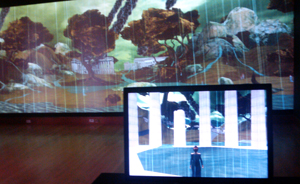
In Cambridge’s City Hall Annex, Children of Arcadia provides a wide vista onto a virtual world as well as a station for interacting. A visitor can guide a female character to different parts of the landscape. The pastoral scene, with the ruins of Wall Street buildings scattered about, features weather and other atmospheric effects that are keyed to current financial conditions. Plummeting stock prices seem to manifest themselves in darkness, rain, and billowing columns of smoke. Bullish markets would lead to sun and clear skies. Steering an avatar through this world could be more enjoyable. It seems that the character can’t affect anything or interact with other wanderers. Still, the view of the landscape and the connection to real-time data makes for a powerful, relevant image and works well in the installation context. The economic crisis is found “in arcadia” here, where the helplessness of the steerable characters is at least appropriate.



